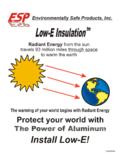Transcription of Hazard Communication Safety Data Sheet Section 1 ...
1 Hazard Communication Safety data SheetIssue Date: 02-20-2015 Page 1 of 5 Section 1, IdentificationProduct NameESP Low-E Reflective InsulationProduct Name, Code #: Low-E, L#### or #L###; Micro-E, M#### or #M###; Ultra-E, U#### or #LUL#; E#### or #E###; V### or #V###; Other product Identifiers:Code numbers. Chemical Name: Plastic/ Aluminum/ PolyethyleneTrade Name: Polyethylene foam, Polyethylene Film, FoilChemical Family: Plastic, Aluminum, PolyethyleneChemical Formula: N/ACompany IdentificationEnvironmentally Safe Products, Inc.
2 313 West Golden LaneNew Oxford, Pa. 17350 USAC ustomer Information Number: 800-289-5693 EMERGENCY TELEPHONE NUMBER 24-Hour Emergency Contact: Thomas Miller717-476-1578 Section 2, Hazard (s) identificationEmergency OverviewAppearance: Solid Plastic Foam. White, Natural, Green, Aluminum. Odor:OdorlessPhysical State: Foam, AluminumHazards of product :No significant immediate hazards for emergency response are known. Potential Health EffectsEye: Solid or Dust may cause irritation or corneal injury due to mechanical action. Flush eyes with plenty of water to remove particulate.
3 Skin Contact: Essentially nonirritating to skin. Mechanical injury only. Wash skin with plenty of water. Skin Absorption: Unlikely due to physical properties. Ingestion: Swallowing is unlikely due to physical properties. Very low toxicity if swallowed. Harmful effects not anticipated from swallowing small amounts. May cause choking or blockage of the digestive tract if swallowed. Induce vomiting if large quantities are swallowed. Inhalation: Dust may cause irritation to upper respiratory tract, nose and throat. Remove to fresh air.
4 Get medical attention. Section 3, Composition informationHazardous IngredientCAS NO. WT% Name: ESP Low-E Reflective Insulation Issue Date: 02-20-2015 Page 2 of 5 Section 4, First-aid measuresEye Contact: Flush eyes with plenty of water to remove particulate. Only mechanical effects expected. Consult physician. Skin Contact: Wash with soap and water. Ingestion: Not likely route of exposure. If large amounts swallowed, seek medical attention. May cause gastrointestinal blockage. Do not give laxatives, and do not induce vomiting unless directed by medical personnel.
5 Inhalation: Move person to fresh air; if effects occur, consult a physician. Section 5, Fire Fighting MeasuresFlash Point:Polyethylene: : Above 450 degrees F. Extinguishing Media: Water fog or fine spray. Dry chemical fire extinguishers. Carbon dioxide fire extinguishers, foam. Fire Fighting Procedures: Keep people away. Isolate fire and deny unnecessary entry. Soak thoroughly with water to cool and prevent re-ignition. If material is molten, do not apply direct water stream. Use fine water spray or foam. Cool surroundings with water to localize fire zone.
6 Hand held dry chemical or carbon dioxide extinguishers may be used for small fires. Special Protective Equipment for Firefighters: Wear positive-pressure self- contained breathing apparatus (SCBA) and protective fire fighting clothing (includes fire fighting helmet, coat, trousers, boots and gloves). If protective equipment is not available or not used, fight fire from a protected location of safe distance. Unusual Fire and Explosion hazards : Trace amounts of residual blowing agent may be present in the foam. Mechanical and thermal processes may produce dust and flammable vapors which may be potential explosion hazards .
7 Tightly sealed containers may burst under fire or intense heat. Dense smoke is emitted when burned without sufficient oxygen. Hazardous Combustion Products: During a fire, smoke may contain the original material in addition to combustion products of varying composition which may be toxic and or irritating. In smoldering or flaming condition, carbon monoxide, carbon dioxide, carbon dioxide and carbon are generated. Based on combustion toxicity testing, the effects of combustion from this foam are not more acutely toxic than the effects of combustion from common building materials such as wood.
8 Section 6, Accidental Release Measures Steps to be Taken if Material is Released: Handle as general inert material. See Section 13, Disposal consideration, for additional information. Personal Precautions: There are no special required instructions. Environmental Precautions: There are no special instructions. Section 7, Handling and Storage HandlingGeneral Handling: Mechanical cutting, or sawing can cause formation of dusts.
9 To reduce the potential for dust explosion, do not permit dust to accumulate. This product is combustible and may constitute a fire Hazard if improperly used or installed. StorageStore in a cool, dry place. Keep away from high temperatures and hot pipes. Store away from direct sunlight. This material is combustible and should not be exposed to flame or other ignition sources. This polyethylene foam is made with flammable hydrocarbon blowing agent, most of which is removed prior to shipment. However, residual flammable vapors may gradually exhaust from the foam during storage, fabrication or use.
10 Avoid close confinement of large foam quantities and sources of ignition near the foam. (IE: smoking, sparks, flames.) Do not store near heating equipment. Burns readily when exposed to plentiful and hot ignition sources. Use self-contained breathing apparatus in the event of fire. product Name: ESP Low-E Reflective Insulation Issue Date: 02-20-2015 Page 3 of 5 Section 8, Exposure Controls/ Personal Protection Exposure LimitsAlthough some of the additives used in this product may have exposure guidelines, these additives are encapsulated in the product and no exposure would be expected under normal handling conditions.
